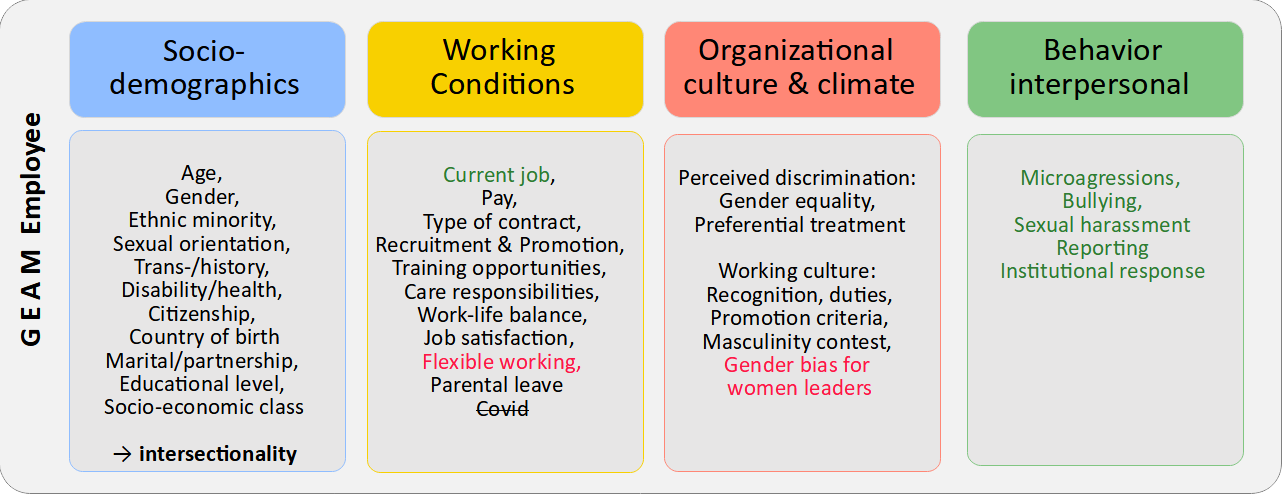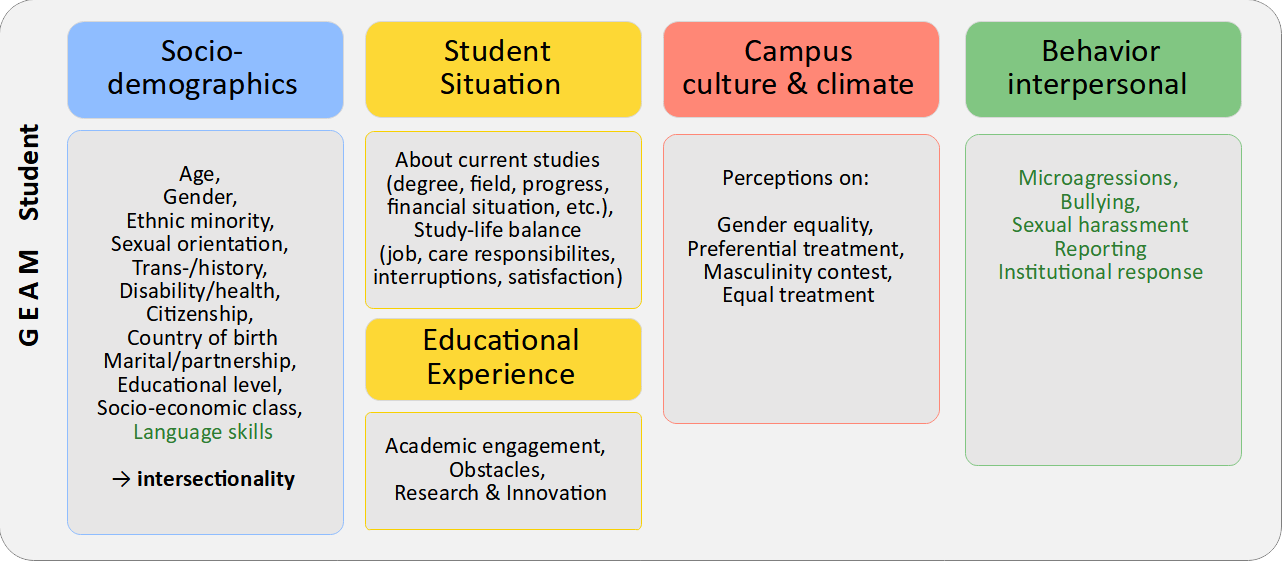1 Introduction
This book guides the statistical analysis of data collected with the GEAM questionnaire. It seeks to inspire and provide concrete suggestions for taking advantage of GEAM data that goes beyond descriptive statistics. The book addresses gender equality working groups (practitioners, gender specialists, administrative staff) who have collected data with the GEAM or another survey in their organisation, but are unsure how to analyse it in more detail. Each chapter is a collaboration between equality practitioners and statisticians, allowing examples from different contexts to be included. As such it introduces the main GEAM variables and how they related to main equality topics such as work-life balance, perceptions of discrimination, organisational culture and climate or experiences of sexual violence. The thematic focus is backed up by R code snippets to facilitate the reproduction of similar analysis with practitioners’ own data.
Gender Equality Plan, Gender Equaliy Audit, Equality Data Monitoring, Intersectionality, Descriptive statistics, Statistical analysis
1.1 Equality data collection and analysis
Collecting and analysing gender equality data is essential for designing effective and sustainable policies and interventions to reduce these inequalities. Data collection not only helps to identify existing gender gaps - for example with regards to wages or experiences of discrimination - but also enables the monitoring of progress over time.
The analysis of inclusive gender equality data involves a deep understanding of the social and cultural contexts in which inequalities arise. This often entails the collection of qualitative as well as quantitative data to understand how experiences of discrimination but also of privilege are shaped by gender and other socio-demographic dimensions such as class, race/ethnicity, disabilities or sexual orientation among others. An intersectional approach, that goes beyond a binary understanding of gender and integrates multiple axis of oppression and privilege, needs to go beyond the collection and analysis of disaggregated data as it is primarily geared towards the transformation structural inequalities and their embedded power relations.
For background information on general principles of equality data collection using the GEAM questionnaire see the online GEAM Manual, especially Chapter 2. For an in-depth look at intersectional challenges for data collection and monitoring see Müller and Humbert (2025).
This book seeks to meet these needs by combining standard and emerging statistical techniques to analyse GEAM data. Using an inclusive and accessible approach, it aims to empower researchers, practitioners, and professionals to use data as a key tool in promoting inclusive gender equality within their organisations.
1.2 What is the GEAM tool?
The Gender Equality Audit and Monitoring (GEAM) tool is a survey framework to collect robust and reliable data on gender equality from both employees (academic and administrative) and students in research and innovation organisations. Its goal is to gather data on perceptions and experiences related to discrimination, working conditions, harassment and microaggressions, job satisfaction among others. Focusing on experiences and perceptions of employees and students, it complements administrative records.
The GEAM tool was initially developed as part of the ACT project Communities of PrACTice for Accelerating Gender Equality and Institutional Change in Research and Innovation across Europe (2018–2021). During the INSPIRE project Building Europe’s Centre of Excellence on Inclusive Gender Equality in R&I (2022-2026), a new questionnaire for students has been developed while the GEAM questionnaire for employees has been updated and revised.
1.2.1 GEAM questionnaires
GEAM v3 for Employees
The GEAM questionnaire for employees gathers data on perceptions and experiences related to gender and other inequalities across four main areas as shown in the following illustration:

Socio-demographics: This dimension gathers information on personal characteristics such as age, gender, ethnic minority, sexual orientation, socioeconomic factors, disability, marital status, citizenship, etc. It highlights the importance of intersectionality in capturing the multiple ways these characteristics interact and generate inequalities.
Working Conditions: Aspects such as current job, pay, contract type, recruitment and promotion practices, training opportunities, work-life balance, and job satisfaction are examined. Special attention is given to factors like flexible work arrangements and parental leave.
Organisational Culture and Climate: This component addresses perceptions of discrimination, gender equality, and preferential treatment, along with cultural elements such as promotion criteria, recognition, and gender biases, particularly against women in leadership roles.
Interpersonal Behaviour: Incidents of microaggressions, workplace harassment, and sexual harassment are explored, along with reporting practices and institutional responses to these behaviours. This provides key insights into interpersonal dynamics within workplace settings.
You can browse the GEAM v3 employee questionnaire here online or consult further the GEAM Manual
GEAM v1 for Students
The GEAM survey for students is based upon the GEAM employee version to a large degree but incorporates specific modules and questions regaring the student experiences, as shown in the following illustration:

Socio-demographics: Similar to the employee survey, this dimension collects data on personal characteristics such as age, gender, ethnic identity, sexual orientation, disability, and socioeconomic class. Additionally, it includes linguistic abilities, which are relevant in multicultural academic settings.
Student situation: This dimension evaluates aspects related to current studies, including degree or programme, academic progress, financial situation, and work-life balance. It also addresses caregiving responsibilities, study interruptions, and overall satisfaction with the educational experience.
Educational experience: This component focuses on academic engagement, obstacles faced by students, and participation in research and innovation activities, which are crucial for assessing inclusion and opportunities in academic settings.
Campus culture and climate: Perceptions of gender equality, preferential treatment, dominant masculinity, and equitable treatment in academic environments are analysed, offering insights into institutional culture.
Interpersonal behaviour: Incidents of microaggressions, bullying, and sexual harassment are explored, alongside institutional responses to these issues, providing a comprehensive view of interpersonal dynamics affecting students.
You can browser the GEAM v1 student questionnaire online here or consult the GEAM Manual
1.2.2 Applications and scope of the GEAM tool
GEAM is recommended for use during the initial stages of developing a Gender Equality Plan (GEP) to identify specific challenges and conduct baseline audits. Additionally, it can be used to monitor progress following the implementation of equality policies. As such it facilitaes the design, execution, and monitoring of organisational strategies.
The tool promotes a participatory approach by involving self-assessment teams that integrate diverse perspectives and expertise within the organisation, ensuring that the results translate into effective evidence-based actions.
GEAM has been utilised by over 50 universities and research centres across Europe, generating more than 10,000 responses. The questionnaires are freely available as LimeSurvey files and can be easily installed and deployed on any LimeSurvey platform. As part of the INSPIRE project, the Universitat Oberta de Catalunya offers a GEAM service, including access to a GEAM instance for conducting surveys.
For further information on setting up and launching GEAM in your organisation, visit the GEAM Manual.
1.3 Target audience of this book
This handbook is intended for gender equality practitioners who have collected data using the GEAM tool within their organisations. The target audience includes gender specialists, administrative staff, and other stakeholders interested in promoting gender equality through the appropriate use of data.
Readers are expected to have a basic understanding of statistics, including fundamental concepts such as types of variables, descriptive statistics, and statistical inference. This level of knowledge will enable effective interpretation and application of the techniques presented in the manual.
In any case we recommend that equality practitioners with little statistical background consult and collaborate with a statistics expert. Expert guidance can facilitate the interpretation of results and ensure that conclusions drawn from the data are robust and reliable. This collaborative approach will maximise the impact of the analysis and its application in gender equality strategies and policies.
Ideally, this book serves as a starting point for fostering dialogue among equality practitioners, data and statistical experts, employees, and students about gender and other forms of inequality within their organizations. We hope it will be both engaging and valuable—offering statisticians insights into gender issues, while supporting gender equality practitioners in developing their skills in quantitative data analysis.
1.4 How to use this book
Having supported many GEAM surveys across European academic organisations has shown that the collected data is often not exploited to its full potential. Most analysis of GEAM data remains on a descriptive level. While a useful first step, more sophisticated analysis should be carried out to detect intersecting inequalities. In order to facilitate a more in-depth analysis, the book has been divided into two parts.
Part I introduces some statistical techniques to be used beyond descriptive statistics. This includes very established techniques used to detect (gender) gaps (Chapter 3), compare results in time (see Chapter 4) or between organisations (see Chapter 5), as well as newer approaches to carry out an intersectional analysis (see Chapter 6) of GEAM data.
Part II then connects these statistical techniques to specific thematic analysis. The different chapters aim to provide an overview of the main GEAM variables and how they relate to specific equality themes such as GEP design (see Chapter 7), work-life balance and conflict (see Chapter 8), workplace culture and climate (see Chapter 9) among others. Hence, part II is especially helpful for readers that are interested in how to approach certain key equality topics with their data.
1.5 How to contribute
This handbook is a living document. New contributions using GEAM data or other sources to showcase interesting analytical perspectives on inclusive gender equality at the organisational level are always welcome. Comments, bug-fixes, corrections are also welcome, preferrable directly through the online repository.
As noted, most chapters have been written in a collaborative effort between gender professionals and statisticians, incorporating examples from various organisations and contexts where GEAM has been used.
The GEAM survey framework, including its many translations, is a collective endeavour that has been built by many contributions from European equality practitioners (see GEAM Manual). Its success reflects this open and collaborative way of working.
The GEAM questionnaire, handbooks and reporting infrastructure is available under the Creative-Commons BY-NC-SA 4.0 license. Meaning you are free to share and adapt the material, as long as you give appropriate credit, do not use it for commerical purposes, and share your results under the same license as the original.